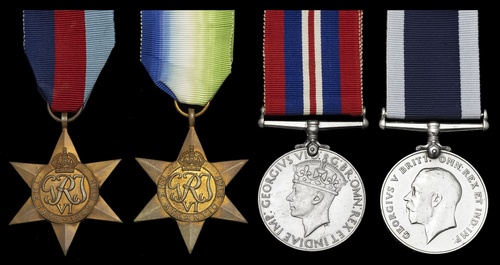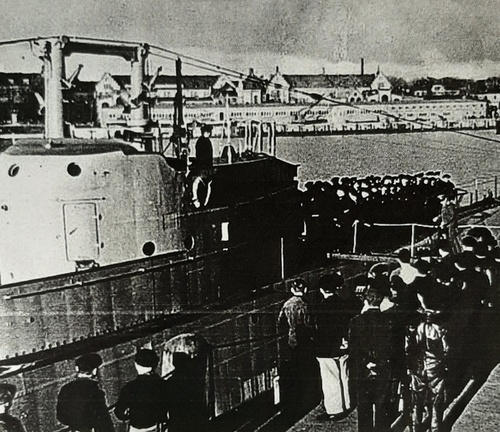Auction: 25001 - Orders, Decorations and Medals
Lot: 85
A rare campaign group of four awarded to Engine Room Artificer Class I H. T. Johnson, Royal Navy, who was taken prisoner of war with H.M.S. Seal, the only British submarine surrendered to the enemy during the Second World War
Interned at Marlag Camp he joined several others - including 'Tubby' Lister of Colditz fame - in digging an escape tunnel: Johnson actually made it out of the camp but was re-captured soon after
1939-45 Star; Atlantic Star; War Medal 1939-45; Royal Navy L.S. & G.C., G.V.R. (M.36487 H.T. Johnson. E.A.1. H.M.S. Pembroke.), some polishing and contact marks, overall very fine (4)
Henry Thomas Johnson was born at Sheerness on 4 May 1900, the son of Thomas and Florence Johnson of 67 Richmond Street, Marine Town, Sheerness. Joining the Royal Air Force as a Flying Cadet on 15 July 1918 he received no medal entitlement with them. Instead he enlisted with the Royal Navy on 4 May 1923 as Engine Room Artificer Class IV with his R.A.F. service of 176 days being carried towards his pension.
Joining at Vernon on 4 May 1922 his first service afloat was with the light cruiser H.M.S. Dunedin on 19 May 1922. Appointed Engine Room Artificer Class II with Cumberland on 4 May 1928 and further advanced Engine Room Artificer Class I whilst ashore on 4 May 1933. Johnson transferred to submarine service with Dolphine on 9 June and served with a number of vessels throughout the late 30s.
He was posted to the crew of Seal on 1 January 1939 not long after she was launched. This Grampus-class mine-laying submarine carried a compliment of 60 men and 50 mines as well as torpedoes and a 4-inch deck gun. When the Second World War broke out Seal was enroute to China however she was detained at Aden and launched several patrols in the area.
Returning to Britain they were patrolling Norwegian waters when Germany invaded and infiltrated Stavangerfjord entering the port of Stavanger. Despite the boldness of the operation it produced few results as the harbour contained no German craft with a deep enough draft to attack with torpedoes. She returned to Britain for a brief refit before setting off back to Norway to undertake Operation DF 7.
They set out of for the Kattegat Sea between Norway, Denmark and Sweden, on 29 April 1940. She had a narrow escape from a Heinkel seaplane but reached the area of operations in good time and completed her mission. As they turned for home they discovered a flotilla of anti-submarine patrol ships ahead of them, with armed trawlers behind them as well. Diving to avoid the enemy the submarine was unable to run deep owning to the shallow depth of the Kattegat Sea, instead they undertook a zig-zag pattern before settling at the bottom of the sea.
Tragically they had entered a minefield and the cable from one of the mines had become caught on one of Seal's hydroplanes. The mine was pulled into the ship and detonated against the hull, causing serious damage. When the dust had settled the situation was grim, the boat had shifted ten degrees upwards due to the amount of water they had taken on, however the enemy warships had failed to notice the explosion and they left the area.
Repeated attempts were made to surface as soon as it was safe however all failed, eventually they dropped their 'drop keel', making it impossible for them to dive again if they made the surface. The pressure of the situation, combined with the worsening quality of the air caused a great deal of pressure all around, Johnson however was not one to be put out by stress, as is made clear in Will Not We Fear which states:
'Throughout the boat men were apathetically accepting the inevitability of death. There really seemed to be nothing left, no other possibility to be worth while trying. And in these circumstances there could be recourse only to humour and to idiosyncrasy and to routine.
The petty officers' mess was the scene of a surprising amount of activity. Electrical Artificer Johnstone [SIC] began removing first the sleeves and then the trousers of his overall suit. "What the hell are you doing, Johnno?" he was asked. "Changing into my Number Ones," he replied. And as soon as he had laboriously dressed himself in his best suit he hoisted himself into his bunk and relaxed… and wait'
Eventually after over a day beneath the waves they managed to refloat Seal, the crew were exhausted and light headed after the stress and oxygen depravation of the day. Making for Swedish waters the submarine came under attack by German aircraft, at this moment one of their engines failed, leaving them becalmed. The two Lewis guns they brought to the deck for protection both jammed and- under increasingly accurate fire- they were forced to surrender.
Seal was the only British Submarine to strike her colours during the war, her crew were taken initially to Stalag XXA, Thorn. Soon afterwards a new camp was completed for Naval personnel called Marlag XB, attached to Stalag 10B. From there they were transferred again to Marlag und Milag Nord, here Johnson was involved in an escape attempt, as outlined in Fatal Ascent:
'Lister and Johnson, Seal ratings, with Hammond of the submarine Shark and eleven others, including Lt. Trevor Beet, participated in a tunnel escape from Marlag at Sandbostel. Once they were on the outside, everybody split up, but they did not get very far before they were nabbed by guards.'
His two companions, Lister and Hammond, were taken to Colditz as a result of their attempt however Johnson seems to have remained at Marlag und Milag Nord.
'"After Tubby Lister and his pal Johnson got caught," commented Mickey Reynolds, "there was hell to pay, but we didn't mind, as we knew we were doing our little bit to keep Jerry occupied." Usually, the escapers and helpers were put in solitary confinement with bread and water for a few days following the Geneva Convention.'
(IBID)
Johnson was repatriated on 19 May 1945 and discharged to the reserve that same year. He served in the Sheerness Dockyard Smithy and lived at "Dunedin", 9 Century Road, Rainham. Johnson died at Kent County Hospital, Chatham in 1976; sold together with a copy of Fatal Ascent and Will Not We Fear along with copied service papers.
Subject to 20% VAT on Buyer’s Premium. For more information please view Terms and Conditions for Buyers.
Estimate
£300 to £400
Starting price
£240







